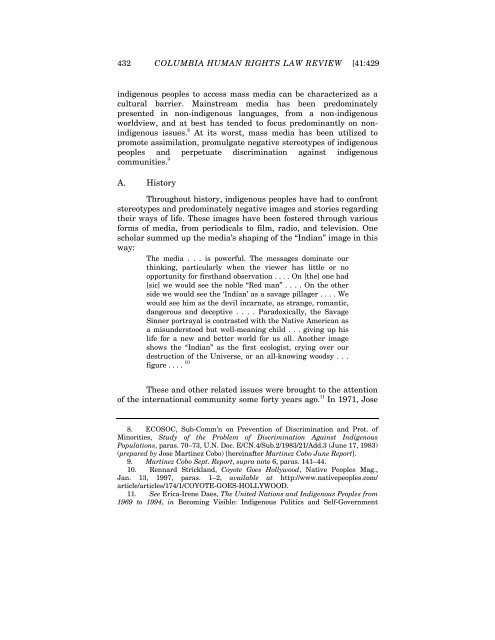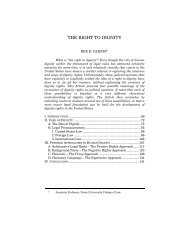A Right to Media? Lorie M. Graham - Columbia Law School
A Right to Media? Lorie M. Graham - Columbia Law School
A Right to Media? Lorie M. Graham - Columbia Law School
Create successful ePaper yourself
Turn your PDF publications into a flip-book with our unique Google optimized e-Paper software.
432 COLUMBIA HUMAN RIGHTS LAW REVIEW [41:429<br />
indigenous peoples <strong>to</strong> access mass media can be characterized as a<br />
cultural barrier. Mainstream media has been predominately<br />
presented in non-indigenous languages, from a non-indigenous<br />
worldview, and at best has tended <strong>to</strong> focus predominantly on nonindigenous<br />
issues. 8 At its worst, mass media has been utilized <strong>to</strong><br />
promote assimilation, promulgate negative stereotypes of indigenous<br />
peoples and perpetuate discrimination against indigenous<br />
communities. 9<br />
A. His<strong>to</strong>ry<br />
Throughout his<strong>to</strong>ry, indigenous peoples have had <strong>to</strong> confront<br />
stereotypes and predominately negative images and s<strong>to</strong>ries regarding<br />
their ways of life. These images have been fostered through various<br />
forms of media, from periodicals <strong>to</strong> film, radio, and television. One<br />
scholar summed up the media’s shaping of the “Indian” image in this<br />
way:<br />
The media . . . is powerful. The messages dominate our<br />
thinking, particularly when the viewer has little or no<br />
opportunity for firsthand observation . . . . On [the] one had<br />
[sic] we would see the noble “Red man” . . . . On the other<br />
side we would see the ‘Indian’ as a savage pillager . . . . We<br />
would see him as the devil incarnate, as strange, romantic,<br />
dangerous and deceptive . . . . Paradoxically, the Savage<br />
Sinner portrayal is contrasted with the Native American as<br />
a misunders<strong>to</strong>od but well-meaning child . . . giving up his<br />
life for a new and better world for us all. Another image<br />
shows the “Indian” as the first ecologist, crying over our<br />
destruction of the Universe, or an all-knowing woodsy . . .<br />
figure . . . . 10<br />
These and other related issues were brought <strong>to</strong> the attention<br />
of the international community some forty years ago. 11 In 1971, Jose<br />
8. ECOSOC, Sub-Comm’n on Prevention of Discrimination and Prot. of<br />
Minorities, Study of the Problem of Discrimination Against Indigenous<br />
Populations, paras. 70–73, U.N. Doc. E/CN.4/Sub.2/1983/21/Add.3 (June 17, 1983)<br />
(prepared by Jose Martinez Cobo) [hereinafter Martinez Cobo June Report].<br />
9. Martinez Cobo Sept. Report, supra note 6, paras. 141–44.<br />
10. Rennard Strickland, Coyote Goes Hollywood, Native Peoples Mag.,<br />
Jan. 13, 1997, paras. 1–2, available at http://www.nativepeoples.com/<br />
article/articles/174/1/COYOTE-GOES-HOLLYWOOD.<br />
11. See Erica-Irene Daes, The United Nations and Indigenous Peoples from<br />
1969 <strong>to</strong> 1994, in Becoming Visible: Indigenous Politics and Self-Government















